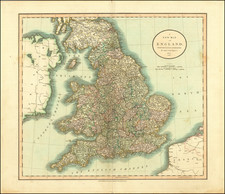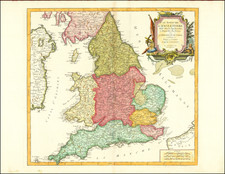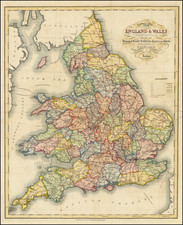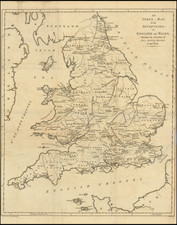Striking and highly detailed map of England in two sheets.
The map meticulously details England's rail and road network, showing an intricate web of thoroughfares connecting even the remotest of hamlets. Major routes, prominently marked, included distances—vital for trade, travel, and post. The roads, often following ancient paths, linked coastal ports, market towns, and cities.
The map also highlights a myriad of cities and towns, from the bustling metropolis of London to the industrious hubs in the North, and the idyllic towns in the countryside. The intricate river system, vital for trade and transportation before the dominance of railways appears depicted prominently. England's rivers, including the Thames, Severn, and Tyne, were central to the country's economic and cultural life.
In the midst of the 19th century, the transportation landscape of England underwent significant transformation, with railways ushering in an era of unprecedented connectivity and economic expansion. An 1840 map of England, with its outline color delineating counties, provides an intricate and informative snapshot of this pivotal time in the nation's history. Beyond the burgeoning railways, this detailed map offers extensive insights into the road systems, including distances on major routes, and remarkably depicts an array of cities, towns, and rivers.
Major Rail Lines
-
The Liverpool and Manchester Railway (L&MR): Opened in 1830, the L&MR was the world's first railway to rely exclusively on steam power, have a double track, and be fully signalled. It connected the major industrial cities of Liverpool and Manchester, facilitating efficient transportation of goods and passengers, and serving as a model for future railways.
-
The London and Birmingham Railway: Operational from 1838, it was an essential part of the emerging national rail network, connecting London to the Midlands. Designed by the notable engineer Robert Stephenson, this line became a vital link in connecting the capital to the North and Scotland.
-
The Great Western Railway (GWR): Designed by Isambard Kingdom Brunel and opened in stages from 1838, the GWR connected London with the West Country and Wales. Renowned for its broad gauge track and engineering marvels, including the Box Tunnel and Clifton Suspension Bridge, it played a crucial role in enhancing western England's connectivity.
-
The Birmingham and Derby Junction Railway: Opened in 1839, this railway provided an essential link between the industrial Midlands and the North, connecting Birmingham and Derby. Its significance lay in the connections it offered to other major lines, thereby integrating further the nation's rail network.
-
The North Midland Railway: Running between Derby and Leeds and opened in 1840, it was one of the three lines that formed the backbone of the Midland Railway. Engineered by George Stephenson, it was celebrated for its architectural elegance, particularly its viaducts.
The Lizars were a Scottish family of engravers and printers who produced many views and maps. Daniel Lizars Sr. (1754-1812) was the son of a shoemaker, but he apprenticed with Andrew Bell, a printer and engraver. Lizars set up his own printworks near St. Giles Cathedral and took on his own apprentices, including George Bartholomew, whose son John would go on to found the important mapmaking firm later know as John Bartholomew & Son Ltd.
Daniel Sr. had three sons: Daniel Jr., John, and William Home. He also had a daughter, Jane Home. Daniel Jr. (1793-1875), the youngest of the boys, apprenticed in his father’s shop alongside George Bartholomew. When his father died in 1812, Daniel Jr. took over much of the business, expanding it and specializing in maps. The company went bankrupt in 1832, however, and Daniel emigrated to Canada.
John Lizars (1792-1860), the middle son, studied medicine and became Professor of Surgery at the Royal College of Surgeons of Edinburgh, as well as senior surgeon at the Royal Infirmary of Edinburgh.
William Home Lizars (1788-1859), the eldest, also apprenticed in his father’s shop. After learning engraving, William entered the Trustees’ Academy to learn under John Graham. He was a skilled painter and artist. When his father died, and after his Daniel Jr. left, he carried on printing and invented a method of etching that looks like wood engraving.










![[ England & Wales ] Map of the Hills, Rivers, Canals, and Principal Roads, of England and Wales, with the Various Lines of Railroads and Exhibiting Most of the Places Whose Situation has been ascertained by the Stations and Intersections of the Trigonometrical Survey, Compiled by A. Arrowmsmith. Hydrographer to His Majesty.](https://storage.googleapis.com/raremaps/img/small/99932.jpg)



